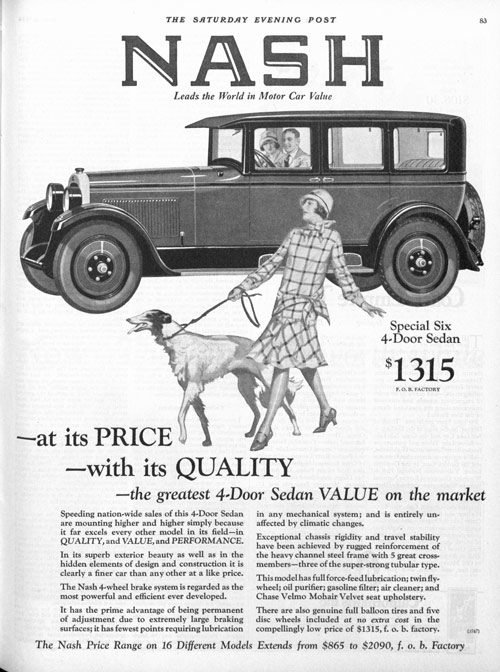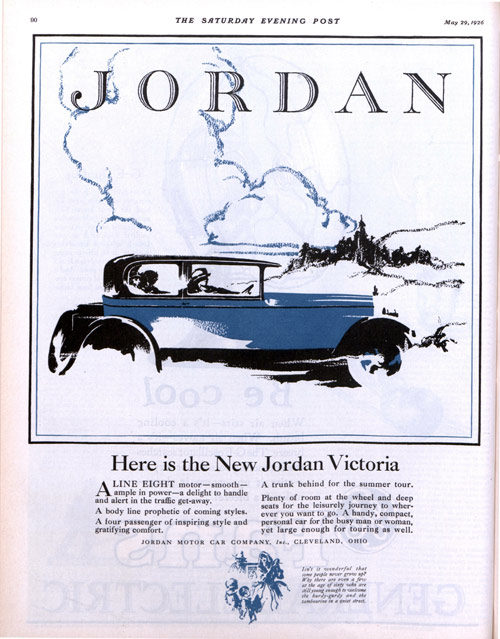The Art of the Post: The Challenge of Illustrating the Earliest Cars
Read all of art critic David Apatoff’s columns here.
The artists of the Saturday Evening Post were sometimes called upon to paint brand-new subjects that had never been painted by traditional artists.
Most of the Post’s illustrators were formally trained in perspective, anatomy, and the other technical skills of art. They learned to paint portraits and landscapes and bowls of fruit. But painting for a weekly periodical is not the same as painting for a gallery or museum. During the long domain of the Post, new inventions such as the radio, airplanes, refrigerators, and televisions were introduced as important phenomena in the daily lives of Americans. When they debuted, they had to be illustrated for the pages of the Post.
This 1929 painting by artist Walter Biggs suggested that the most elegant black-tie parties would benefit from having a Frigidaire-brand refrigerator in the living room so the guests could have ice cubes in their drinks:

There were no paintings by old masters to serve as models for these modern illustrations. Rembrandt never painted a skyscraper or an electric fan. The Post’s artists had to make it up as they went along. Painting the physical object was difficult enough, but the real challenge was to anticipate the cultural significance of the new inventions. What role would they serve? How should they be portrayed?
There’s no better example of this than the early illustrations of cars. It was clear from the very beginning that every family would want a car.
This 1925 illustration by artist M. Leone Bracker depicts a family on their front porch enviously watching their neighbors’ cars drive by. They are stranded, staring while their neighbors have been freed by their automobiles to go “everywhere.”


Before the public had figured out the best ways to use this strange new invention, or even how they preferred it to look, illustrators for the first car ads had to decide on the best way to portray cars.
Some artists tried to relate cars to classical mythology, depicting gods of speed or flight.

Other artists linked the automobile to modern art and design, which was born around the same time as cars.

Illustrator E. Everett Henry (1893-1961) painted this early car in an idealized, art deco style for the May 29, 1926 issue of the Post. Thirty years later when people understood cars better, Henry would illustrate a car as a commonplace everyday nuisance, driving too fast through family neighborhoods.
Some illustrators tried to have it both ways, portraying cars as an invention for both the city and the country markets.

Of course, artists through the ages have always been able to promote products by placing an attractive woman in front of them, even if she has no connection to the product itself:


For a brief period, the Dodge Brothers Company apparently believed the best way to advertise cars was to show paintings of their “mohair velvet upholstery,” which was supposedly comfortable to sit on while watching parades. This campaign did not last long.

A wide variety of artistic talents tried their hand at creating the visual identity of cars. Some of the top illustrators in America who illustrated covers for the Post and other magazines would also paint ads for the auto manufacturers.
In the following picture, an unknown illustrator has left out all the details, giving us just a simplified suggestion of a car. By only implying what the car will do, he leaves it up to his audience to fill in all the details in their minds and imagine how great their new car will be:

In the next example, the illustrator Major Felten (1904-1975) treads very carefully, drawing the car objectively with a light, realistic line. Felten became well known for his bold, exciting paintings of jungle cats and savage warriors, which he created with a heavily stylized look. By comparison this plain vanilla illustration looks timorous, as if he hasn’t quite figured out what to make of this new invention.

Note how many different car companies flourished in those early years as designers and manufacturers experimented with how the new invention should look and function. At the same time, creative artists were offering many different approaches to artistic interpretations of the automobile, giving us this diverse collection of creative pictures. While the artists’ impressions of a car have changed dramatically in the last hundred years, we can still see in these early efforts the same factors that motivate car buyers today— status, luxury, safety, comfort, value, beauty, and good old Fear of Missing Out.